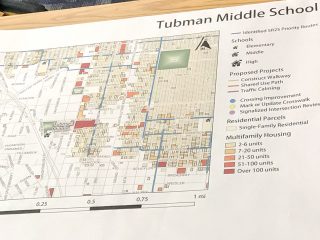
(Photos: Jonathan Maus/BikePortland)
“We believe kids coming to this school need an elevated skillset to navigate these streets.”
— Dana Dickman, PBOT
This is the meeting that should have taken place before two students where hit.
On Tuesday, Harriet Tubman Middle School officials and bureau of transportation staff met with parents who are concerned that their children will be run over by automobile users while walking and biking to class. Tubman sits on Flint Avenue, a busy driving route that’s the main access to the Broadway Bridge. One block northeast is the wide and fast intersection of North Russell Avenue and Vancouver. Interstate 5 — and all its associated hazards — is literally in the school’s backyard.

Traffic safety concerns were on the table before the school year started. When a girl was hit on her way to school while walking in a crosswalk in October, parents raised their voices even louder. “Everyone’s afraid their kid is going to get hit,” parent Jillian Wieseneck shared when I met her outside the school a week later.
Then it happened again. On January 11th, another student was hit while trying to cross the street just one block away from the previous collision and two blocks away from the school’s main entrance.
Tubman, formerly an all-girls school, closed in 2012 due to low enrollment. It then served as temporary home for a different school before re-opening last fall.

Advertisement

“From a racial perspective, when our kids of color, specifically black kids, see a policeman, that affects them.”
— Lavell Wood, Tubman vice-principal
Lavell Wood is Tubman’s vice principal. At the outset of this week’s meeting he stressed that the newness of Tubman has added to safety challenges. “In terms of transportation,” he said, “When Faubion was here it was short-term. But now we’re here for good and things that worked for Faubion may not work for us.” Wood was happy to see parents in the room and added that, “We want to hear from you, because this is so huge we can’t fix it ourselves.”
While he’s grateful for parent participation, Wood said he wanted to make sure everyone was, “Keeping race and culture on the table.” He said he’s heard some parents want police to direct traffic during morning drop-off (an idea that didn’t come up during the meeting). “From a racial perspective, when our kids of color, specifically black kids, see a policeman, that affects them. Will it be stopping them from coming into the building and being ready to learn?” Wood also reminded attendees that the school is located in what used to be a “thriving black community” and he encouraged everyone to find ways to bring more voices to the table.
The Portland Bureau of Transportation had three staffers in the room: Traffic Safety/Safe Routes to School Manager Dana Dickman (a planner), Lale Santelices who’s on the Safe Routes community engagement team, and spokesman Dylan Rivera.
Dickman helped lead a year-long Safe Routes planning process that delved more deeply into conditions at all public schools. Part of that process, she said, was talking to community leaders and parents about specific concerns with getting to school. But that didn’t happen at Tubman. “We couldn’t to that in advance of Tubman,” she explained, “Because we didn’t actually know what those routes were going to be. It was hard for parents, the summer before they’ve ever been here, to know what those routes would have looked like and where they thought their kids would go.”
Tuesday’s meeting was a chance to play catch-up. Dickman asked parents to help identify, “primary investment routes.” She also added a note of caution, perhaps not wanting to disappoint anyone who thinks a few infrastructure fixes and student education programs will solve the problems.
“You’re dealing with a more urban context than many other neighborhoods,” Dickman explained, referring to the traffic conditions in the area. “It is very intense. You have emergencies coming to the hospital [Legacy Emanuel and emergency room is just a few blocks away], there are lots of places funneling onto the freeway [the school backs up to I-5], you have a very constrained situation. Even with improvements, that constrained situation is still going to be there.”
Dickman then said because of that, educating students should be a top priority. “We believe kids coming to this school need an elevated skillset to navigate these streets — even more so than other neighborhoods. And we want to help provide that.” Dickman warned the parents that even with great infrastructure, bad things can still happen. “We have a significant issue with pedestrian crashes in Portland and almost half of them happen at signalized intersections. So even in places where we think we have the safest infrastructure, we’re still having challenges and conflicts.”
Teaching middle schoolers about traffic safety is no easy task. Vice Principal Wood said only two students have signed up for the school’s crossing guard club so far (someone suggested a party and/or prizes to help sweeten the deal).
“There’s so much traffic calming on Vancouver for the hospital. There should be as much — or more — for our kids.”
— Joan Petit, school parent
While there was a lot of talk about student education, the role of parents was also discussed. Dickman and her staff have observed conditions during drop-off and pick-up and have noticed that parents, “have some challenges following rules.” Parent Joan Petit added that, “We need parents dropping off kids educated as much as we need our kids educated.”
A few parents who ride bicycles suggested that bicycle riders avoid the area by staying off Flint Ave and continuing south Vancouver until Tillamook. One parent (whose name I didn’t get), said, “I bike down flint. And I’m part of the problem, not the solution!” Then she added, “Stop biking down Flint unless you’re dropping a kid off!”
Joan Petit, another parent who bikes daily and agrees avoiding the two blocks of Flint in front of the school is a good idea, would like to see Flint no longer be a designated driving route to the Broadway Bridge. The problem with that however, is Flint is considered the only feasible route because it’s illegal to turn right (west) off Vancouver onto Broadway. And if PBOT directed drivers past the school and onto Tillamook (to avoid most congested area of Flint), they’d be putting more cars onto an important cycling route (Tillamook is a neighborhood greenway).
When asked why Flint can’t be closed to through auto traffic, PBOT didn’t sound too enthusiastic. Safe Routes staffer Lale Santelices said they could explore the possibility, “But that would be a bigger lift.”
Beyond finding a way to move traffic (driving and biking) off Flint, there seemed to be a consensus that more signage is needed to let people know that Flint between Russell and Tillamook is a school zone. “People are driving on Russell and Vancouver like it’s an arterial. You can’t tell there’s a school nearby,” said Petit. In her mind, the school deserves the same traffic safety attention that Legacy hospital has received. “There’s so much traffic calming on Vancouver for the hospital,” she said, “There should be as much — or more — for our kids.”
One of main takeaways of the meeting was a productive session of poring over a large map and comparing notes and feedback on various routes and hot-spots.
With talk of which routes where good/bad, safe/unsafe, parent Katrina Yuen shared a lament about what we require people to know simply to ride a bike. “You have to know not to ride a bike on Flint or on MLK, but that’s a lot for people to keep in mind. Ideally, in a cycling city, you shouldn’t have to know which roads to ride on.”
While there’s no major progress to report, the meeting was a step forward. Tubman’s PTSA now has a transportation safety subcommittee (this was its first meeting), priorities are taking shape, and relationships are being built around these issues. If you’d like to get involved or share your perspective, contact Vice Principal Wood at lwood@pps.net or PBOT at saferoutes@portlandoregon.gov.
— Jonathan Maus: (503) 706-8804, @jonathan_maus on Twitter and jonathan@bikeportland.org
Never miss a story. Sign-up for the daily BP Headlines email.
BikePortland needs your support.


